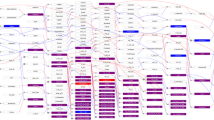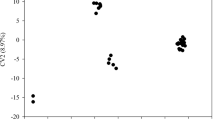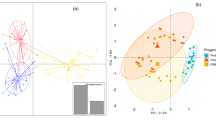Abstract
Passion fruit is an economically important tropical fruit crop with unrealized genetic potential. This study aimed to provide breeders with essential estimates of genetic parameters and of the structure of a typical breeding population. To achieve this, eighty-one progenies derived from the third cycle of recurrent selection were assessed for eight fruit yield and quality traits. First, we evaluated the efficiency of the post hoc implementation of a Row–Col design for data analysis instead of the original randomized complete block design (RCBD). Next, we applied a restricted maximum likelihood/best linear unbiased prediction (REML/BLUP) mixed model to estimate genetic parameters: variance components, heritability, and genetic correlations. The population genetic structure was evaluated using 10 simple sequence repeat (SSR) markers. Results indicate that the post hoc blocking fit the data significantly better or equally to the RCBD. Soluble solids content showed the highest heritability value (0.53 ± 0.087) while yield presented the lowest estimate (0.24 ± 0.090). The 10 SSR loci amplified a total of 29 alleles revealing that the progenies evaluated could be divided into three groups. This grouping information can be used to direct future crosses of this population to maximize heterosis for the traits of interest. Correlations among variables indicate that the number of fruit can be used as a proxy for yield. Future population evaluation studies should consider incomplete block designs to maximize the land and labor resources.



Similar content being viewed by others
References
Bernardo R (2002) Genotype × environment interaction. In: Bernardo R (ed) Breeding for quantitative traits in plants. Stemma Press, Woodbury, pp 147–171
Bhateria S, Sood SP, Pathania A (2006) Genetic analysis of quantitative traits across environments in Linseed (Linum ustitatissimum L). Euphytica 150(1–2):185–194
Chen Y, Lübberstedt T (2010) Molecular basis of trait correlations. Trends Plant Sci 15:454–461
Choudhary P, Khanna SM, Jain PK, Bharadwaj C, Kumar J, Lakhera PC, Srinivasan S (2012) Genetic structure and diversity analysis of the primary gene pool of chickpea using SSR markers. Genet Mol Res 11(2):891–905
Costa e Silva J, Dutkowski GW, Gilmour AR (2001) Analysis of early tree height in forest genetic trials is enhanced by including a spatially correlated residual. Can J For Res 31:1887–1893
de Freitas JPX, Oliveira EJ, Jesus ON, da Cruz Neto AJ, Santos LR (2012) Development of a base population for recurrent selection in yellow passion fruit using selection indexes. Pesq Agrop Bras 47:393–401
de Moraes MC, Geraldi IO, Matta FP, Vieira MLC (2005) Genetic and phenotypic parameter estimates for yield and fruit quality traits from a single wide cross in yellow passion fruit. HortScience 40(7):1978–1981
de Oliveira EJ, Santos VS, Lima DS, Machado ML, Lucena RS, Motta TBN (2011) Genotypic and phenotypic correlation estimates from passion fruit germplasm. Bragantia 70(2):255–261
de Silva FHL, Viana AP, Ferreira RT, de Freitas JCO, Santos JO, Rodrigues DL (2014) Measurement of genetic diversity in progenies of sour passion fruit by Ward-MLM methodology: a strategy for heterotic group formation. Revista Ciência e Agrotecnologia 38:1234–1239
Doyle JJ, Doyle JL (1990) Isolation of plant DNA from fresh tissue. Focus 12:13–15
EMBRAPA (2006) Empresa Brasileira de Pesquisa Agropecuária. Centro Nacional de Pesquisa do Solo. Sistema brasileiro de classificação de solos. 2 ed Rio de Janeiro
Evanno G, Regnaut S, Goudet J (2005) Detecting the number of clusters of individuals using the software structure: a simulation study. Mol Ecol 14(8):2611–2620
Falconer DS (1989) Introduction to quantitative genetics, 3rd edn. Longmans Green/Wiley, Harlow, Essex, UK/New York
Faleiro FGF, Junqueira NTV, Braga MF (2005) Germoplasma e melhoramento genético do maracujazeiro: Desafios da pesquisa. In: Faleiro FGF, Junqueira NTV, Braga MF (eds) Maracujá: germoplasma e melhoramento genético. Embrapa Cerrados, Planaltina, pp 55–78
Faleiro FGF, Farias Neto AL, Ribeiro WQ (2008) Pré-melhoramento, melhoramento e pós-melhoramento: estratégias e desafios. Embrapa Cerrados 1 ed Planaltina
Filippi CV, Aguirre N, Rivas JG, Zubrzycki J, Puebla A, Cordes D, Moreno MV, Fusari CM, Alvarez D, Heinz RA, Hopp HE, Paniego NB, Lia VV (2015) Population structure and genetic diversity characterization of a sunflower association mapping population using SSR and SNP markers. BMC Plant Biol 15(52):1–12
Freitas ILDJ, Amaral Junior AT, Viana AP, Pena GF, Cabral PS, Vittorazzi C, Silva TRDC (2013) Genetic gain evaluated with selection indices and with REML/Blup in popcorn. Pesq Agrop Bras 48(11):1464–1471
Gezan SA (2005) Optimal design and analysis of clonal forestry trials using simulated data. PhD Thesis, University of Florida
Gezan SA, Huber DA, White TL (2006) Post hoc blocking to improve heritability and precision of best linear unbiased genetic predictions. Can J For Res 36:2141–2147
Gilmour AR, Gogel BJ, Cullis BR, Welham SJ, Thompson R (2002) ASReml User Guide Release 1.0 VSN International Ltd., Hemel Hempstead
Gilmour AR, Gogel BJ, Cullis BR, Thompson R (2009) ASReml user Guide release 3.0. VSN International Ltd., Hemel Hempstead
Gonçalves GM, Viana AP, Pereira MG, Bezerra Neto FV, Amaral AT, Pereira TNS (2008) Phenotypic and genetic-additive correlations in yellow passion fruit obtained by design I. Ciência e Agrotecnologia 32:1413–1418
Gonçalves GM, Viana AP, Pereira MG, Bezerra Neto FV, do Amaral Júnior AT, Pereira TNS, Gonçalves TJM (2009) Genetic parameter estimates in yellow passion fruit based on design I. Braz Arch Biol Tech 52:523–530
Griffing B (1956) Concept of general and specific combining ability in relation to diallel crossing system. Aust J Biol Sci 9:463–493
IBGE (2014) Instituto Brasileiro de Geografia e Estatística. Banco de dados agregados: produção agrícola municipal. Rio de Janeiro. Found at: http://www.sidra.ibge.gov.br/bda/tabela/listabl.asp?c=1613&z=p&o=29
Kempton RA, Seraphin JC, Sword AM (1994) Statistical analysis of two-dimensional variation in variety yield trials. J Agric Sci 122:335–342
Laviola BG, Rosado TB, Bhering LL, Kobayashi AK, Resende MDV (2010) Genetic parameters and variability in physic nut accessions during early developmental stages. Pesquisa Agropecuária Brasileira 45(10):117–1123
MAPA, Ministério da Agricultura, Pecuária e Abastecimento. Registro Nacional de Cultivares. Found at: www.extranet.agricultura.gov.br/php/snpc/cultivarweb/cultivares_regis.php. Last accessed 11 Jan, 2015
Marin ALA, Costa MR, Sartorato A, Peloso MJD, Barros EG, Moreira MA (2003) Genetic variability and pedigree analysis of Brazilian common bean elite genotypes. Scientia Agricola 60(2):283–290
Martins MR, Oliveira JC, Di Mauro AO, Silva PC (2003) Evaluation of sweet passion fruit (Passiflora alata Curtis) populations obtained by open polinization. Rev Bras Frutic 25(1):111–114
Mrode RA. (2005) Linear models for the prediction of animal breeding values, 2nd edn. CABI Publishing, Oxfordshire, UK.
Mulamba NN, Mock JJ (1978) Improvement of yield potential of the Eto Blanco maize (Zea mays L.) population by breeding for plant traits. Egypt J Genet Cytol 7:40–51
Muse SV, Gault S (1994) A likelihood approach for comparing synonymous and non-synonymous substitution rates, with application to the chloroplast genome. Mol Biol Evol 11:715–724
Neves LG, Bruckner CH, Picanço MC, Sobrinho SP, Araújo KL, Luz PB, Barelli MAA, Krause W (2013) Genetic correlation between agronomically important traits in yellow passion fruit. Amer J Plant Sci 4:2112–2117
Oliveira EJ (2006) Development of microsatellite markers and their use for the generation and integration of genetic maps of yellow passion fruit (Passiflora edulis Sims f. flavicarpa Deg.) PhD Thesis. (Genetics and Plant Breeding), ESALQ, São Paulo
Ortiz DC, Bohórquez A, Duque MC, Tohme J, Cuéllar D, Vásquez TM (2012) Evaluating purple passion fruit (Passiflora edulis Sims f. edulis) genetic variability in individuals from commercial plantations in Colombia. Genet Resour Crop Evol 59:1089–1099
Patterson HD, Hunter EA (1983) The efficiency of incomplete block designs in national list and recommended list cereal variety trials. J Agric Sci Camb 103:427–433
Pritchard JK, Stephens M, Donnell YP (2000) Inference of population structure using multilocus genotype data. Genetics 155(2):945–959
Reis RV, Oliveira EJ, Viana AP, Pereira TNS, Pereira MG, Silva MGM (2011) Genetic diversity in recurrent selection of yellow passion fruit detected by microsatellites markers. Pesq Agrop Bras 46:51–57
Reis RV, Viana AP, Oliveira EJ, Silva MGM (2012) Phenotypic and molecular selection of yellow passion fruit progenies in the second cycle of recurrent selection. Crop Breed Appl Biotechnol 12(1):17–24
Resende MDV(2000) Análise estatística de modelos mistos via REML/BLUP na experimentação em melhoramento de plantas perenes, Colombo
Santos EA, Souza MM, Viana AP, Almeida AA, Freitas JCO, Lawinscky PR (2011) Multivariate analysis of morphological characteristics of two species of passion flower with ornamental potential and of hybrids between them. Genet Mol Res 10(4):2457–2471
Santos EA, Viana AP, Freitas JCO, Rodrigues DL, Tavares RF, Paiva CL, Souza MM (2015a) Genotype selection by REML/BLUP methodology in a segregating population from an interspecific Passiflora spp Crossing. Euphytica 204(1):1–11
Santos EA, Viana AP, Freitas JCO, Rodrigues DL, Tavares RF, Paiva LC, Souza MM (2015b) Genotype selection by REML/BLUP methodology in a segregating population from an interspecific Passiflora spp. crossing. Euphytica 204(1):1–11
Silva MGM (2009) Recurrent selection intra-populational in passion fruit. PhD Thesis. (Plant Production), Universidade Estadual Norte Fluminense
Silva MGM, Viana AP (2012) Alternatives of selection in a yellow passion fruit population under intrapopulation recurrent selection. Revista Brasileira de Fruticultura 34(2):525–531
Silva MGM, Viana AP, Gonçalves GM, Júnior ATA, Pereira MG (2009) Intrapopulation recurrent selection in yellow passion fruit: alternative to accumulate genetic gains. Ciência Agrotécnica 33(1):170–176
Viana AP, Pereira TNS, Pereira MG, de Souza MM, Maldonado JFM, do Amaral Júnior AT (2003) Simple and canonic correlation between agronomical and fruit quality traits in yellow passion fruit (Passiflora edulis f. flavicarpa) populations. Crop Breed Appl Biotechnol 3(2):133–140
Viana AP, Pereira TNS, Pereira MG, Amaral Júnior AT, Souza MM, Maldonado JFM (2004) Genetic parameters in populations of yellow passion fruit. Revista Ceres, Viçosa 51(297):541–551
Wong YS, Sia CM, Khoo HE, Ang YK, Chang SK, Yim HS (2014) Influence of extraction conditions on antioxidant properties of passion fruit (Passiflora edulis) peel. Acta Sci Pol Technol Aliment 13(3):257–265
Acknowledgments
The authors are thankful to the Foundation for Research Support of the State of Rio de Janeiro (FAPERJ) and National Council for Scientific and Technological Development (CNPq), for the financial support to the experiment, and the Coordination of Improvement of Higher Education Personnel (CAPES), for the granting of a doctoral scholarship for the first author.
Author information
Authors and Affiliations
Corresponding author
Rights and permissions
About this article
Cite this article
Silva, F.H.L., Muñoz, P.R., Vincent, C.I. et al. Generating relevant information for breeding Passiflora edulis: genetic parameters and population structure. Euphytica 208, 609–619 (2016). https://doi.org/10.1007/s10681-015-1616-8
Received:
Accepted:
Published:
Issue Date:
DOI: https://doi.org/10.1007/s10681-015-1616-8




